Picking up pennies in front of the bulldozer
By Colin Twiggs
August 27th, 2015 6:30 p.m. AET (4:30 a.m. EDT)
Advice herein is provided for the general information of readers and does not have regard to any particular person's investment objectives, financial situation or needs. Accordingly, no reader should act on the basis of any information contained herein without first having consulted a suitably qualified financial advisor.
"Picking up pennies in front of a bulldozer" comes to mind when viewing the current situation, where many stocks have rallied after breaking through primary support. Markets find short-term support and the temptation is to snap up bargains. But probabilities have inverted. Buying on the dips is no longer the profitable strategy that it was in the bull market — with high probability of substantial gains outweighing the low probability of material losses. We are now in a bear market where we face low probability of material gains versus high probability of substantial losses.
Why have probabilities inverted? There are two types of sellers active during a crash: astute investors seeking to reduce their market exposure; and traders seeking to profit from the fall by selling stocks short. The first group are likely to sit on the sidelines after they have sold, waiting for the turmoil to pass. But short-sellers tend to take profits when the initial spurt of selling slows, their purchases encouraging a few brave souls to venture into the market, picking up pennies in front of the bulldozer. There are two forces ranged against these buyers. First, short-covering will fade as the market rises and short sales are likely to again rise. Second, there is a large group of investors sitting on stocks who missed the opportunity to reduce their exposure during the initial sell-off. Their confidence now shaken after the sharp fall, the group forms a large block of resistance. As stocks rise, they enter the market in increasing numbers, causing the rally to falter. When the rally falters, the number of sellers swells alarmingly, initiating a second decline. The cycle may repeat several times until eventually new buyers enter the market.
The market in times like this is driven by sentiment. Gauging reaction to good and bad news is the best measure of investor resilience.
North America
The S&P 500 found short-term support at 1870 and is now rallying to test former primary support at 1980/2000. Respect of the new resistance level — or respect of zero by 21-day Twiggs Money Flow — would signal that the rally has failed. Rising volumes would strengthen the signal. Follow-through above 2000 is less likely but would not indicate a change in the primary down-trend.
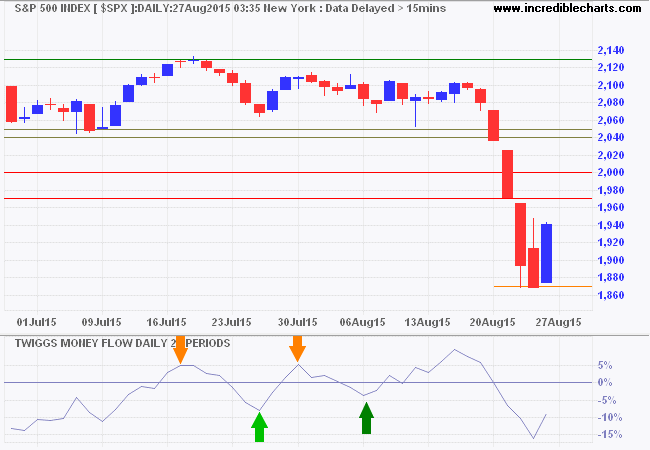
* Target calculation: 1900 - ( 2000 - 1900 ) = 1800
The CBOE Volatility Index (VIX) indicates elevated market risk.
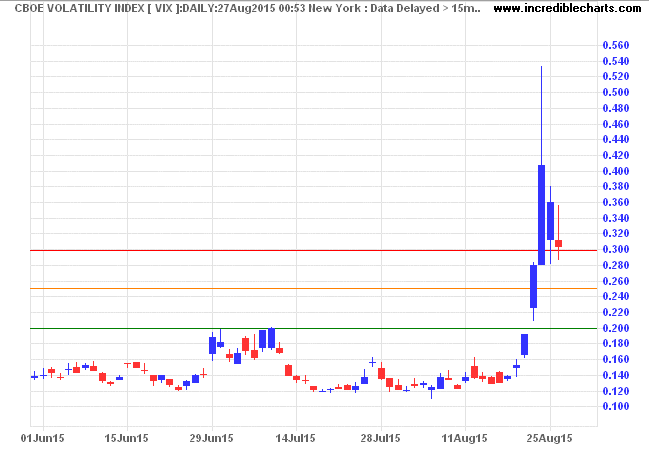
Do not be deceived by a sharp retreat after the initial spike, as occurred in early May 2010 below.
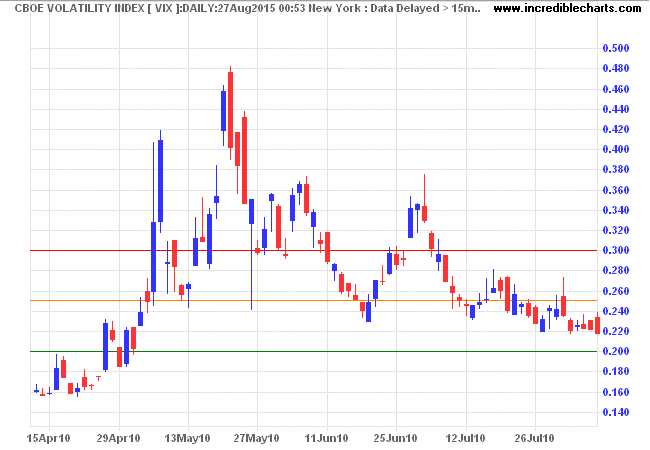
Bellwether transport stock Fedex's strong bear trend warns of declining economic activity.
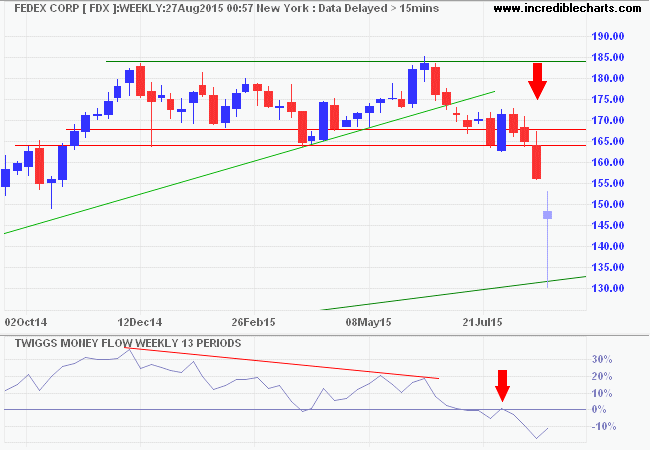
Despite falling transport indicators, improving housing and light vehicle sales suggest that the US will recover faster than most other markets. But whether that is days or months is difficult to tell at present.
Canada's TSX 60 rallied to test resistance at 800. Recovery above the primary support level would be insufficient to indicate that the primary down-trend has reversed. Declining 13-week Twiggs Momentum below zero continues to warn of a strong down-trend. Target for the decline is 700*.
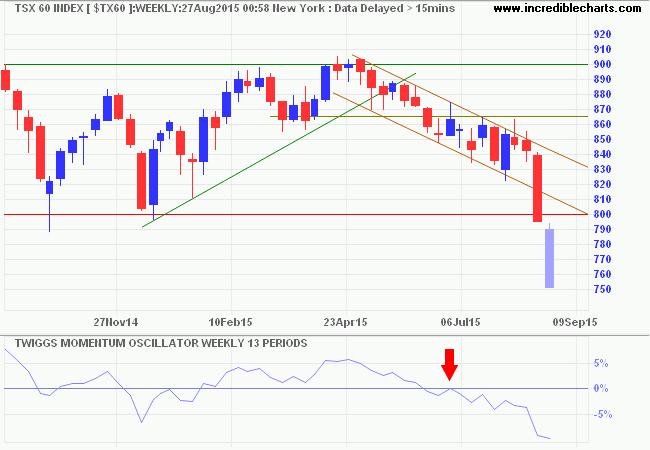
* Target calculation: 800 - ( 900 - 800 ) = 700
Europe
Dow Jones Euro Stoxx 50 is testing primary support at 3000. Reversal of 13-week Twiggs Money Flow below zero would warn of a primary down-trend. Recovery above 3300 is as likely, however, and would indicate that the up-trend is intact.
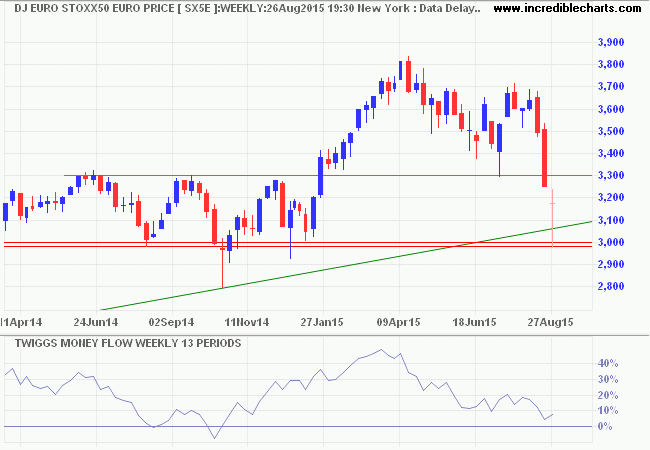
Asia
Dow Jones Shanghai index rallied today, but this looks like a dead cat bounce. Respect of resistance at 440 is likely and would offer a target of 330*. Declining 13-week Twiggs Momentum signals a strong primary down-trend. .
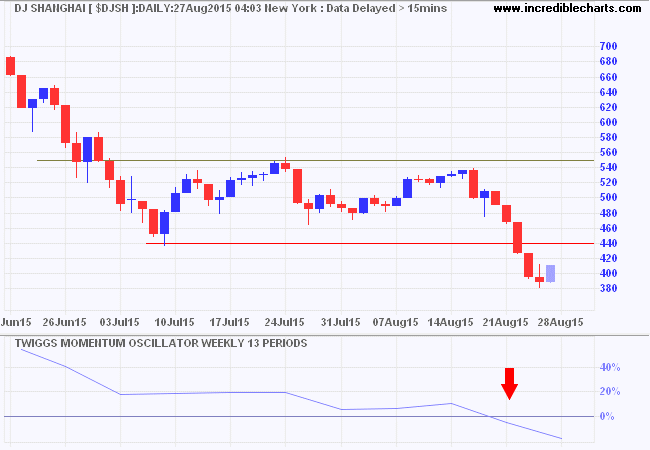
* Target calculation: 440 - ( 550 - 440 ) = 330
Japan's Nikkei 225 is testing resistance at 19000 but a re-test of primary support at 17000 is likely. Declining 13-week Twiggs Money Flow indicates medium-term selling pressure.
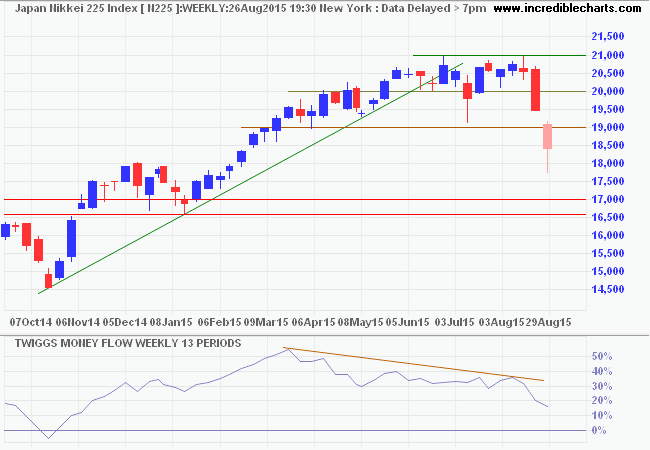
* Target calculation: 19000 - ( 21000 - 19000 ) = 17000
India's Sensex rallied above 26000 at time of writing but probability of a primary down-trend is high after breaking support at 26000/26500. Reversal of 13-week Twiggs Money Flow below zero would confirm.
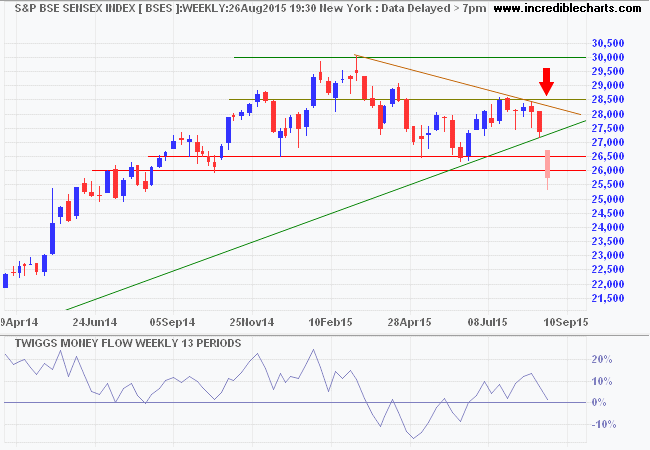
* Target calculation: 27000 - ( 30000 - 27000 ) = 24000
Australia
The ASX 200 rallied off support at 5000. Respect of resistance at 5400 is likely, however, and would warn of another test of 5000. Recovery of 21-day Twiggs Money Flow above zero would indicate buying support. Reversal below 5000 would confirm the primary down-trend, while respect would suggest a double bottom.
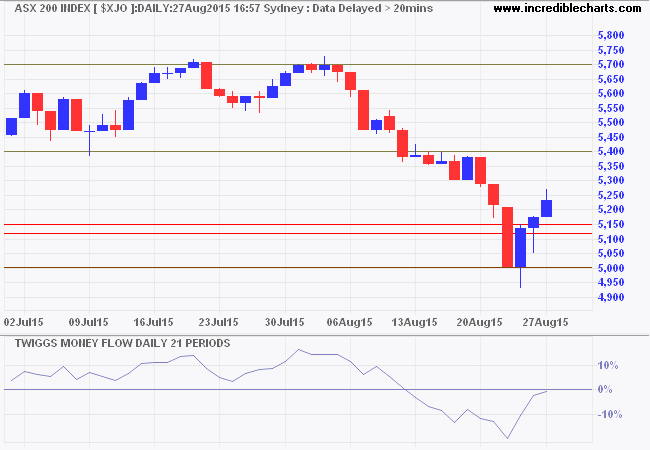
* Target calculation: 5000 - ( 5400 - 5000 ) = 4600
A global society does not mean a global state. To abolish the existence of states is neither feasible nor desirable; but insofar as there are collective interests that transcend state boundaries, the sovereignty of states must be subordinated to international law and international institutions.
~ George Soros: The Crisis of Global Capitalism (1998)
Disclaimer
Research & Investment Pty Ltd is a Corporate Authorized Representative (AR Number 384 397) of Andika Pty Ltd which holds an Australian Financial Services Licence (AFSL 297069).
The information on this web site and in the newsletters is general in nature and does not consider your personal circumstances. Please contact your professional financial adviser for advice tailored to your needs.
Research & Investment Pty Ltd ("R&I") has made every effort to ensure the reliability of the views and recommendations expressed in the reports published on its websites and newsletters. Our research is based upon information known to us or which was obtained from sources which we believe to be reliable and accurate.
No guarantee as to the capital value of investments, nor future returns are made by R&I. Neither R&I nor its employees make any representation, warranty or guarantee that the information provided is complete, accurate, current or reliable.
You are under no obligation to use these services and should always compare financial services/products to find one which best meets your personal objectives, financial situation or needs.
To the extent permitted by law, R&I and its employees, agents and authorised representatives exclude all liability for any loss or damage (including indirect, special or consequential loss or damage) arising from the use of, or reliance on, any information. If the law prohibits the exclusion of such liability, such liability shall be limited, to the extent permitted by law, to the resupply of the said information or the cost of the said resupply.
Important Warning About Simulated Results
Research & Investment (R&I) specialise in developing, testing and researching investment strategies and systems. Within the R&I web site and newsletters, you will find information about investment strategies and their performance. It is important that you understand that results from R&I research are simulated and not actual results.
No representation is made that any investor will or is likely to achieve profits or losses similar to those shown.
Simulated performance results are generally prepared with the benefit of hindsight and do not involve financial risk. No modeling can completely account for the impact of financial risk in actual investment. Account size, brokerage and slippage may also diverge from simulated results. Numerous other factors related to the markets in general or to the implementation of any specific investment system cannot be fully accounted for in the preparation of simulated performance results and may adversely affect actual investment results.
To the extent permitted by law, R&I and its employees, agents and authorised representatives exclude all liability for any loss or damage (including indirect, special or consequential loss or damage) arising from the use of, or reliance on, any information offered by R&I whether or not caused by any negligent act or omission.

Author: Colin Twiggs is a former investment banker with almost 40 years of experience in financial markets. He co-founded Incredible Charts and writes the popular Trading Diary and Patient Investor newsletters.
Using a top-down approach, Colin identifies key macro trends in the global economy before evaluating selected opportunities using a combination of fundamental and technical analysis.
Focusing on interest rates and financial market liquidity as primary drivers of the economic cycle, he warned of the 2008/2009 and 2020 bear markets well ahead of actual events.
He founded PVT Capital (AFSL No. 546090) in May 2023, which offers investment strategy and advice to wholesale clients.
